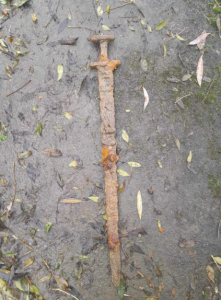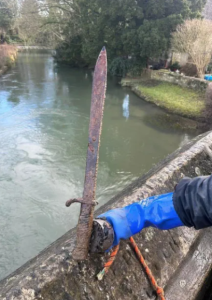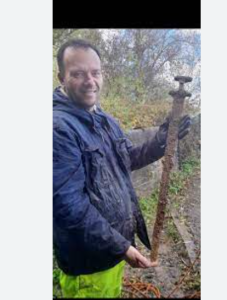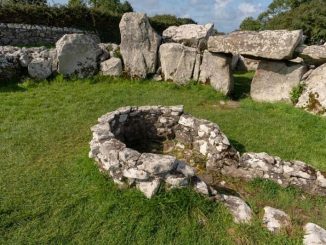Introduction
In the serene landscapes of Oxfordshire, a remarkable discovery has emerged from the depths of history, challenging our understanding of the region’s ancient past. An enthusiast practicing magnet fishing, a hobby that combines the thrill of treasure hunting with environmental cleanup, pulled an extraordinary find from the water: a Viking sword, dating back to between 850 and 975 A.D. This remarkable artifact, identified by a finds liaison officer, is not only the oldest object ever discovered in Oxfordshire through magnet fishing but also a significant piece of Viking heritage. This blog post explores the discovery, its historical significance, and the implications for our understanding of Viking presence in England.

A Serendipitous Discovery: The Viking Sword Unveiled
The story of the Viking sword’s discovery reads like a narrative from a bygone era, where the past reaches out to the present through the veil of time. The individual who unearthed this ancient warrior’s blade was engaged in magnet fishing—a method of searching for metal objects in bodies of water using powerful magnets. What was expected to be a day of finding lost trinkets or discarded metal turned into a historical revelation when the magnet latched onto something extraordinary. The sword, which was subsequently identified as a Viking artifact, provides a tangible link to the Norsemen who once traversed and influenced the British Isles. The images of this well-preserved sword, now circulating among historians and enthusiasts alike, offer a glimpse into its intricate craftsmanship and the era it heralds from.

The Sword’s Tale: Echoes of Viking Influence in Oxfordshire
The significance of this discovery extends far beyond its initial surprise. The Viking sword offers compelling evidence of the Norse presence and influence in Oxfordshire during the late 9th to 10th centuries. This period was marked by the Viking incursions and settlements that shaped much of England’s historical trajectory. The sword, with its distinctive design and construction, speaks to the craftsmanship and martial prowess of the Vikings. Its presence in Oxfordshire suggests a complex narrative of interaction—whether through trade, settlement, or conflict—between the Vikings and the Anglo-Saxons. This artifact enriches our understanding of the region’s history, revealing a layer of cultural and historical confluence that had remained hidden until now.

In the Hands of Preservation: Ensuring a Future for the Past
The immediate transfer of the Viking sword to museum professionals underscores the importance of preserving such discoveries for future generations. This swift action ensures that the sword will be conserved, studied, and eventually displayed with the care it deserves, allowing it to educate and inspire. The conservation process, often painstaking and meticulous, will provide insights into the materials and methods used in its creation, further contributing to our knowledge of Viking craftsmanship and metallurgical skills. The anticipated display of this artifact in a museum setting will allow the public to connect with a tangible piece of their ancient heritage, bringing history to life in a way that textbooks cannot match.

A Gateway to Ancient Discoveries: The Significance of Magnet Fishing Finds
The discovery of the Viking sword in Oxfordshire by magnet fishing highlights the potential of this hobby to contribute to historical and archaeological research. While magnet fishing is often pursued for recreational purposes, its capacity to unearth artifacts that have lain hidden for centuries offers a new avenue for uncovering the past. This method of discovery, coupled with the cooperation between hobbyists and professionals, can augment traditional archaeological efforts, revealing objects and stories that might otherwise remain undiscovered. Such finds not only enrich our historical record but also underscore the importance of preserving and studying our shared heritage. As we continue to explore the waters and lands of our ancestors, each discovery serves as a reminder of the complex tapestry of human history that surrounds us, waiting to be revealed.

Conclusion
The serendipitous discovery of a Viking sword in Oxfordshire by an enthusiast of magnet fishing has opened a new chapter in the region’s history, offering a vivid glimpse into the Viking Age in England. This artifact serves as a testament to the rich tapestry of interactions that defined the early medieval period. As the sword finds a new home within the walls of a museum, it bridges the past with the present, inviting us to explore the depths of history and the enduring legacy of the Vikings in Oxfordshire. This remarkable find not only highlights the value of hobbies like magnet fishing in uncovering ancient treasures but also reminds us of the importance of preserving such discoveries, allowing them to inform and inspire for generations to come.



